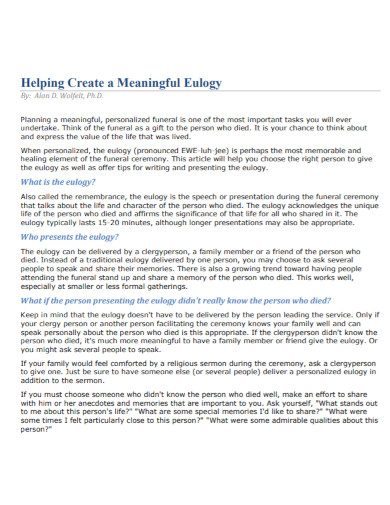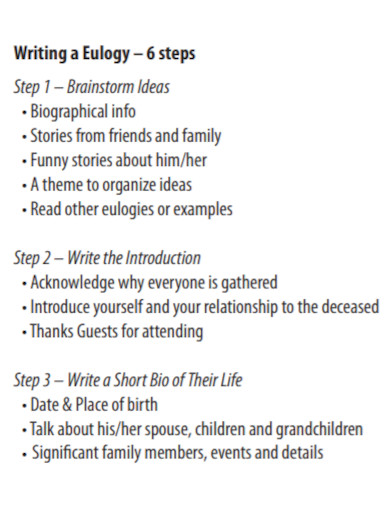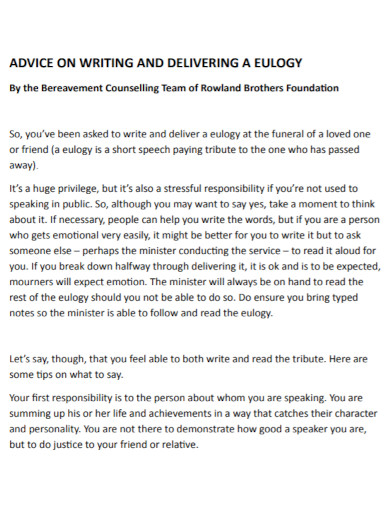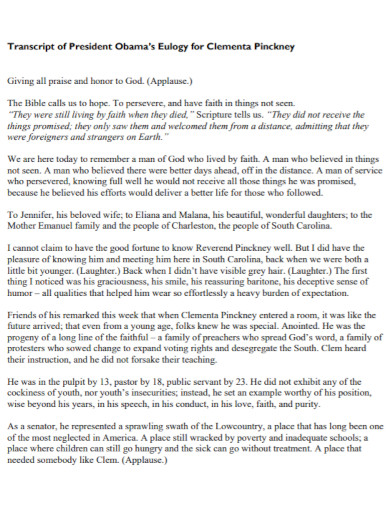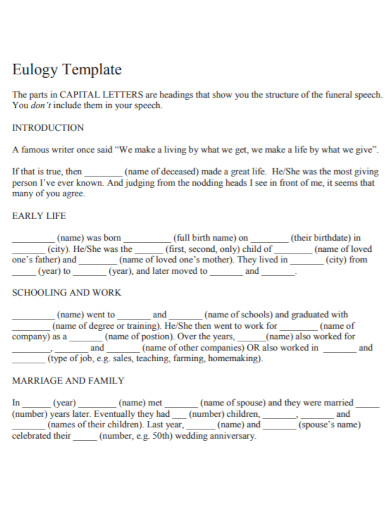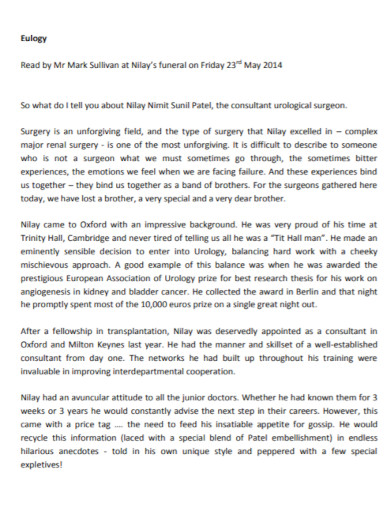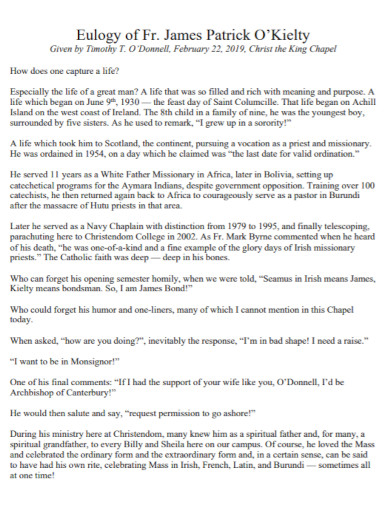15+ Eulogy Examples
Writing a eulogy is a meaningful way to celebrate the life of a loved one. It offers an opportunity to reflect on their unique qualities, share personal memories, and express gratitude for the moments you shared. Crafting a thoughtful eulogy can provide comfort and help preserve their legacy.
Many elements and components that go into a person’s funeral when they have just recently passed from their lives. One of the most important components is the eulogy.
What Is a Eulogy?
A eulogy is a speech or written tribute that honors and remembers someone who has passed away. It is typically delivered during a funeral or memorial service by a close friend, family member, or clergy. A eulogy highlights the deceased’s life, achievements, and character, offering comfort and reflection for those grieving.
Eulogy Examples for Father
1. Personal and Heartfelt
Introduction
Good afternoon, everyone. My name is [Your Name], and I am honored to stand before you today to speak about my father, [Father’s Name].
Body
Dad was the kind of person who could light up a room with his smile. He had an incredible sense of humor, always finding a way to make us laugh, even in the toughest times. One of my favorite memories of Dad is our Sunday morning fishing trips. He taught me patience and the value of spending time together.
Dad was also a man of great integrity. He worked tirelessly to provide for our family, always ensuring we had everything we needed. He was my role model, teaching me the importance of hard work and dedication.
Conclusion
Thank you all for being here to honor my father. Though he may no longer be with us, his spirit lives on in the lessons he taught us and the love he showed us. Let’s remember Dad not with sadness, but with gratitude for the amazing person he was.
2. Reflective and Poetic
Introduction
Hello everyone. My name is [Your Name], and today I have the honor of sharing a few words about my father, [Father’s Name].
Body
Dad was a man of quiet strength and endless wisdom. He had a way of turning simple moments into cherished memories. One such memory is the time we spent under the stars, where he would tell me stories about the constellations. His love for the universe was infectious, and it inspired me to always look up and dream big.
In the words of Maya Angelou, “People will forget what you said, people will forget what you did, but people will never forget how you made them feel.” Dad made everyone feel valued and loved. His kindness and compassion were his greatest gifts to the world.
Conclusion
As we say goodbye to Dad, let us carry forward his legacy of love, kindness, and endless curiosity. Thank you for being here to celebrate his life.
3. Celebratory and Light-hearted
Introduction
Good afternoon. I’m [Your Name], and today I’d like to share some joyful memories of my father, [Father’s Name].
Body
Dad was the life of the party. He had a knack for making everyone around him feel at ease with his jokes and infectious laughter. One Christmas, he dressed up as Santa Claus, much to the delight of all the kids. It was moments like these that showcased his playful spirit and boundless energy.
But beyond his humor, Dad was a man of great wisdom. He always knew just what to say to guide us through life’s challenges. His advice, “Always face the world with a smile,” is something I carry with me every day.
Conclusion
Thank you all for joining us to celebrate Dad’s life. He may no longer be with us in person, but his laughter, wisdom, and love will continue to resonate within us. Let’s honor his memory by embracing the joy and humor he brought into our lives.
Eulogy Examples for Family Member
1. Eulogy for a Mother
Introduction
Good afternoon, everyone. My name is Emily, and today I have the honor of speaking about my mother, Linda Johnson.
Body
Mom was the heart and soul of our family. Her love and warmth touched everyone she met. I remember how she would always have a home-cooked meal ready for us, no matter how busy she was. Her cooking was an expression of her love and care, and those meals brought us together as a family. Her famous apple pie was a staple at every family gathering, and it always brought a smile to our faces.
Mom was also an incredibly strong and resilient woman. She faced life’s challenges with grace and determination, teaching us the importance of perseverance and hope. When Dad passed away, she held us together, showing us what true strength looked like. Her wisdom and guidance were our pillars of strength, and her advice was something we always cherished.
Conclusion
Thank you all for being here to honor my mother. Though she is no longer with us, her love, strength, and wisdom will continue to guide us. Let us celebrate her life and the beautiful memories she left behind. We will carry her legacy in our hearts forever.
2. Eulogy for a Grandparent
Introduction
Hello everyone. My name is Michael, and I am grateful to share some words about my grandfather, William Thompson.
Body
Grandpa was a storyteller. His tales of the old days were captivating and filled with life lessons. I’ll never forget the afternoons spent on his porch, listening to his stories about growing up during the Great Depression and his adventures as a young man. His stories were not just entertaining; they were filled with lessons about resilience and gratitude.
Grandpa had a gentle spirit and a kind heart. He always had time for us grandchildren, teaching us about patience, respect, and the value of hard work. His garden was his pride and joy, and he spent hours teaching us how to nurture it, just as he nurtured us. The tomatoes we grew together always tasted sweeter because they were grown with his love and care.
Conclusion
Thank you all for joining us to remember my grandfather. His stories, kindness, and love will forever be in our hearts. Let’s honor his memory by living the values he taught us and sharing his stories with future generations.
3. Eulogy for a Sibling
Introduction
Good afternoon. I’m Sarah, and today I want to share some memories of my beloved brother, David Anderson.
Body
David was my best friend and confidant. We shared countless laughs, secrets, and adventures. One of my favorite memories is when we took that spontaneous road trip to the Grand Canyon. We had no plans, just a sense of adventure and the open road ahead of us. It was one of the most memorable experiences of my life.
David had a vibrant spirit and a compassionate heart. He was always there for me, offering support and encouragement. He volunteered at the local animal shelter, and his love for animals was evident in everything he did. His kindness extended beyond our family, touching the lives of many who were fortunate enough to know him.
Conclusion
Thank you all for being here to celebrate my brother’s life. Though he is no longer with us, his spirit, laughter, and love will always be a part of us. Let’s keep his memory alive by sharing the joy and compassion he brought into the world. We will continue to live our lives in a way that would make David proud.
Eulogy Examples for a Friend
1. Eulogy for a Childhood Friend
Introduction
Good afternoon, everyone. My name is Sarah, and I am honored to share some memories of my dear friend, Emily Turner, who I’ve known since we were children.
Body
Emily and I met in kindergarten, and from that moment, we were inseparable. We shared countless adventures, from building forts in the backyard to our first day of high school. One of my favorite memories is the summer we spent camping with our families. We stayed up late, whispering secrets and dreaming about our futures. Emily’s laughter was infectious, and her adventurous spirit made every moment unforgettable.
Emily was not only a wonderful friend but also a kind and generous person. She volunteered at the local animal shelter, showing her love and compassion for animals. Her dedication to helping others was inspiring, and she always encouraged me to be the best version of myself. Her kindness touched everyone she met, and she had a unique ability to make people feel special.
Conclusion
Thank you all for being here to honor Emily’s memory. Though she is no longer with us, her spirit will live on in the cherished memories we all share. Let’s remember Emily with love and gratitude for the joy she brought into our lives. We will carry her adventurous spirit and kind heart with us always.
2. Eulogy for a College Friend
Introduction
Hello everyone. My name is Jason, and I have the privilege of speaking about my dear friend, Mark Johnson, who I met during our college years.
Body
Mark and I met during our freshman year at university, and we quickly became best friends. We bonded over our shared love for music and late-night study sessions. One of my fondest memories is when we decided to form a band. Our performances may not have been perfect, but the fun we had and the bond we created were priceless.
Mark was a loyal and supportive friend. He was always there to lend an ear or offer a helping hand. When I was going through a tough time, Mark was the one who stood by me, providing unwavering support and encouragement. His sense of humor and positive outlook on life were truly remarkable, and he had a way of lifting the spirits of everyone around him.
Conclusion
Thank you all for coming to remember Mark. His friendship, loyalty, and humor made a lasting impact on all of us. Let’s honor his memory by cherishing the moments we shared and continuing to support one another, just as Mark would have wanted. We will carry his positive spirit with us in our hearts.
3. Eulogy for a Work Friend
Introduction
Good afternoon. I’m Lisa, and today I want to share some memories of my colleague and dear friend, Karen Smith.
Body
Karen and I worked together for over a decade, and during that time, she became much more than a coworker—she became a true friend. We shared many laughs, challenges, and successes at work. One memory that stands out is when we collaborated on a major project. Despite the long hours and stress, Karen’s unwavering dedication and infectious enthusiasm made it an enjoyable and rewarding experience.
Karen was an incredible friend, always ready with a smile and a kind word. She had a unique ability to make everyone feel valued and appreciated. Outside of work, Karen was passionate about community service, dedicating her time to various charitable organizations. Her generosity and compassion were evident in everything she did, and she inspired us all to give back to our communities.
Conclusion
Thank you all for being here to celebrate Karen’s life. Her dedication, kindness, and friendship will always be remembered. Let’s honor her memory by continuing to support and uplift each other, just as Karen did. We will carry her spirit of generosity and compassion with us always.
Eulogy Examples for Grandmother
1. Eulogy for a Grandmother: Loving and Nurturing
Introduction
Good afternoon, everyone. My name is Emily, and today I have the honor of speaking about my beloved grandmother, Helen Smith.
Body
Grandma Helen was the epitome of love and warmth. She had an incredible ability to make everyone feel at home. Her kitchen was the heart of our family gatherings, filled with the aroma of her delicious cooking and the sound of laughter. One of my fondest memories is baking cookies with her every holiday season. She taught me the perfect recipe, but more importantly, she taught me the value of patience and love.
Grandma had a nurturing spirit that extended beyond our family. She was always ready to help a neighbor in need or offer a kind word to a stranger. Her generosity knew no bounds, and she made a positive impact on everyone she met. She volunteered at the local community center, sharing her love and wisdom with others.
Conclusion
Thank you all for being here to honor Grandma Helen. Though she is no longer with us, her spirit lives on in the love and kindness she shared. Let’s celebrate her life by continuing to spread the warmth and generosity she embodied every day.
2. Eulogy for a Grandmother: Inspirational and Wise
Introduction
Hello everyone. My name is Michael, and I am grateful to share some words about my grandmother, Margaret Thompson.
Body
Grandma Margaret was a source of inspiration and wisdom. She had a wealth of knowledge that she shared generously with all of us. I remember the countless afternoons spent in her garden, where she taught me about plants and the importance of nurturing growth. Her garden was a reflection of her life—beautiful, diverse, and full of love.
Grandma had an incredible resilience that inspired us all. She faced life’s challenges with grace and determination. Her stories of overcoming obstacles during her youth were both humbling and motivating. She taught us that with hard work and perseverance, anything is possible. Her advice and life lessons will remain with us forever.
Conclusion
Thank you all for joining us to celebrate Grandma Margaret’s life. Let’s honor her memory by embracing the lessons she taught us and living with the same strength and determination she exemplified. Her wisdom will continue to guide us, and her love will forever be in our hearts.
3. Eulogy for a Grandmother: Joyful and Fun-loving
Introduction
Good afternoon. I’m Sarah, and today I want to share some joyful memories of my grandmother, Dorothy Johnson.
Body
Grandma Dorothy was the life of every family gathering. She had an infectious laugh and a playful spirit that made every moment special. One of my favorite memories is our annual family game nights. Grandma was always the most competitive, but also the most fun. Her joy and enthusiasm brought our family closer together.
Grandma had a talent for making even the simplest occasions feel like a celebration. She loved to dance, and she would often turn on music and dance around the living room, inviting us all to join her. Her energy and zest for life were truly remarkable and left a lasting impression on all of us.
Conclusion
Thank you all for being here to celebrate Grandma Dorothy’s life. Let’s honor her by embracing the joy and fun she brought into our lives. Let’s dance, laugh, and create beautiful memories, just as she did. Her spirit will continue to light up our lives and bring us together.
Eulogy Examples for Grandfather
1. Eulogy for a Grandfather: Wise and Inspirational
Introduction
Good afternoon, everyone. My name is John, and today I have the privilege of sharing some words about my beloved grandfather, William Thompson.
Body
Grandpa William was a beacon of wisdom and inspiration in our lives. His stories about growing up during challenging times were filled with life lessons that have shaped who I am today. I remember sitting by his side as he recounted tales of his youth, each story more fascinating than the last. His ability to find silver linings in difficult situations taught us resilience and optimism.
Grandpa had an incredible work ethic and a passion for learning. He believed in the power of education and encouraged us to pursue our dreams relentlessly. His favorite saying was, “Knowledge is the greatest treasure you can give yourself,” and he lived by these words every day. His dedication to personal growth inspired everyone around him.
Conclusion
Thank you all for being here to celebrate Grandpa William’s life. Though he is no longer with us, his wisdom and teachings will guide us forever. Let’s honor his memory by continuing to learn, grow, and face life’s challenges with the same strength and determination he exemplified.
2. Eulogy for a Grandfather: Loving and Gentle
Introduction
Hello everyone. My name is Michael, and I am honored to speak about my grandfather, Robert Carter, who was a source of endless love and kindness in our lives.
Body
Grandpa Robert was a gentle soul with a heart full of love. He had a unique way of making everyone feel special and valued. I have fond memories of the times we spent fishing at the lake. Those quiet moments, filled with his stories and laughter, were some of the best times of my life. His patience and kindness taught me the importance of appreciating the simple joys in life.
Grandpa’s love for his family was evident in everything he did. He was always there to offer a comforting hug or a word of encouragement. His support was unwavering, and he made sure we knew how much he cared. His legacy of love is something that we will cherish and carry forward in our own lives.
Conclusion
Thank you all for coming to celebrate Grandpa Robert’s life. His love and kindness touched all of us deeply. Let’s honor his memory by showing the same love and compassion to those around us, just as he did every day of his life. His gentle spirit will continue to inspire us.
3. Eulogy for a Grandfather: Adventurous and Fun-loving
Introduction
Good afternoon. I’m Sarah, and today I want to share some joyful memories of my grandfather, Thomas Green, who brought so much fun and adventure into our lives.
Body
Grandpa Thomas was the epitome of an adventurous spirit. He had a zest for life that was truly infectious. One of my favorite memories is the summer we spent exploring national parks. Grandpa had a knack for turning every trip into an adventure, filled with stories around the campfire and hikes that took us to breathtaking places. His love for the great outdoors instilled in us a deep appreciation for nature.
Grandpa’s sense of humor and playful nature made every moment with him memorable. He was always the one to start a game or tell a joke, bringing laughter and joy to our family gatherings. His ability to find joy in every situation was a lesson in itself, teaching us to approach life with positivity and a light heart.
Conclusion
Thank you all for being here to celebrate Grandpa Thomas’s life. Let’s honor his adventurous spirit by seeking out new experiences and finding joy in the world around us. His laughter and love for life will continue to echo in our hearts, inspiring us to live fully and joyfully.
More Eulogy Templates & Examples in PDF
1. Meaningful Eulogy
2. Eulogy Format
3. Eulogy Template
4. Eulogy Transcript
5. Eulogy Template in PDF
6. Sample Eulogy
7. Short Eulogy
8. Printable Eulogy Example
9. Sample Eulogy Examples
10. Draft Eulogy Template
Types of Eulogy
Eulogies come in various forms, each tailored to honor the deceased in a unique way. Here are the main types:
- Personal Eulogy: A heartfelt speech delivered by a close family member or friend, sharing personal anecdotes and memories.
- Formal Eulogy: Often given by a clergy member or officiant, focusing on the deceased’s life achievements and character.
- Celebratory Eulogy: Emphasizes celebrating the deceased’s life, highlighting joyous moments and achievements.
- Poetic Eulogy: Incorporates poems, verses, or literary references that were significant to the deceased or reflect their life.
- Biographical Eulogy: Provides a detailed account of the deceased’s life history, including milestones and accomplishments.
- Collaborative Eulogy: Multiple people contribute to the eulogy, sharing different perspectives and stories about the deceased.
Eulogy vs. Obituary
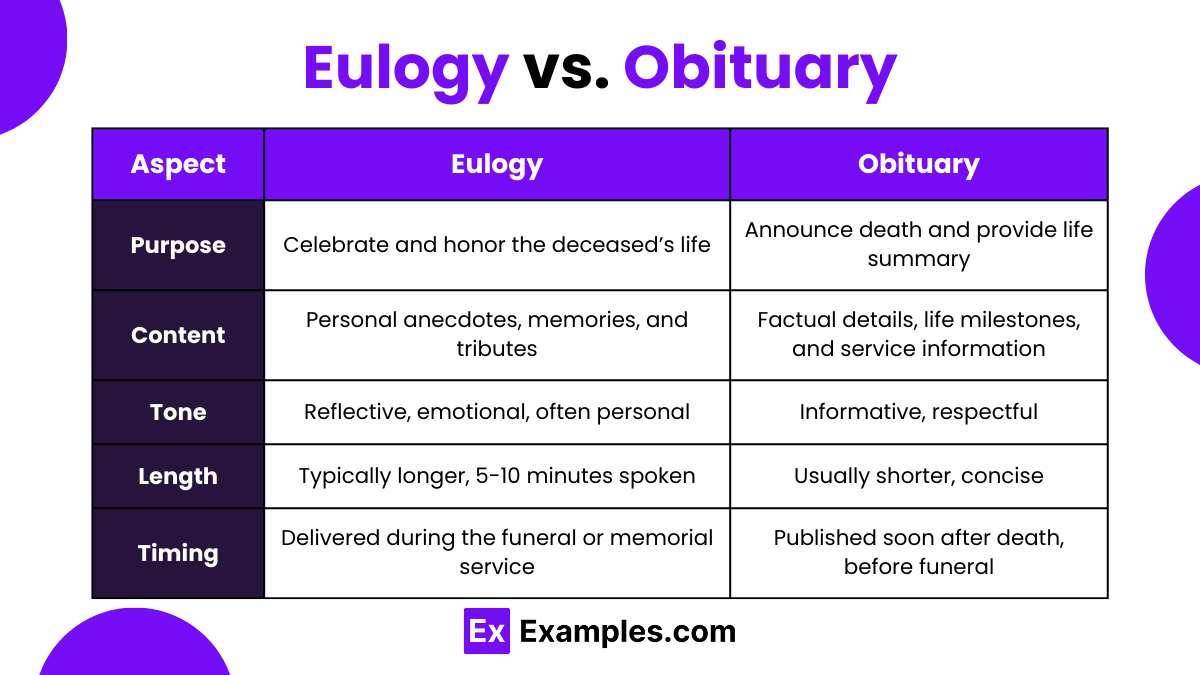
| Aspect | Eulogy | Obituary |
|---|---|---|
| Purpose | Celebrate and honor the deceased’s life | Announce death and provide life summary |
| Content | Personal anecdotes, memories, and tributes | Factual details, life milestones, and service information |
| Tone | Reflective, emotional, often personal | Informative, respectful |
| Length | Typically longer, 5-10 minutes spoken | Usually shorter, concise |
| Audience | Family, friends, attendees at a funeral or memorial | General public, community |
| Timing | Delivered during the funeral or memorial service | Published soon after death, before funeral |
| Focus | Emotional impact, personal connection | Biographical details, public announcement |
| Format | Speech or written tribute | Written notice in newspapers or online |
| Involvement | Often involves personal stories and reflections | Typically involves factual reporting |
| Authorship | Usually written by a close friend or family member | Often written by family or funeral home |
How to Deliver a Eulogy
Delivering a eulogy can be an emotional and challenging task. Here are steps to help you prepare and deliver a meaningful tribute:
Preparation
- Gather Information:
- Talk to family and friends to collect stories and memories.
- Reflect on your own experiences with the deceased.
- Organize Content:
- Create an outline with an introduction, body, and conclusion.
- Include personal anecdotes, significant achievements, and cherished memories.
- Keep it brief, aiming for 5-10 minutes.
- Write the Eulogy:
- Start with a strong opening that captures attention.
- Use clear and simple language.
- End with a heartfelt conclusion that offers comfort.
Practice
- Rehearse:
- Practice reading the eulogy aloud multiple times.
- Time yourself to ensure it’s within the desired length.
- Adjust for clarity and flow.
- Get Feedback:
- Share the eulogy with a trusted friend or family member for feedback.
- Make necessary revisions.
Delivery
- Stay Calm and Composed:
- Take deep breaths to manage your emotions.
- Have a glass of water nearby.
- Speak Clearly:
- Use a steady and measured pace.
- Enunciate your words to ensure everyone can hear.
- Use Notes:
- Bring a printed copy of the eulogy.
- Highlight key points to stay on track.
- Engage with the Audience:
- Make eye contact occasionally.
- Acknowledge the emotions in the room.
How to Start a Eulogy
Beginning a eulogy can be challenging. Here are effective ways to start a eulogy, ensuring it captures attention and sets the tone for a meaningful tribute:
1. Introduce Yourself
- Example: “Good afternoon, everyone. My name is John, and I had the honor of being Jane’s friend for over 20 years.”
2. Express Gratitude
- Example: “Thank you all for being here today to celebrate the life of our beloved Jane.”
3. Share a Personal Anecdote
- Example: “One of my earliest memories of Jane is from our college days when she helped me through a tough exam week with her endless humor and encouragement.”
4. Quote a Relevant Verse or Poem
- Example: “As Robert Frost once said, ‘In three words I can sum up everything I’ve learned about life: it goes on.’ Jane truly embodied this sentiment.”
5. Highlight a Unique Trait or Accomplishment
- Example: “Jane had an incredible knack for making everyone around her feel special. Her ability to listen and empathize was unparalleled.”
6. Set the Tone with a Reflective Statement
- Example: “Today, we gather not just to mourn Jane’s passing but to celebrate the incredible life she lived and the legacy she leaves behind.”
How to End a Eulogy
Concluding a eulogy can leave a lasting impression. Here are ways to close your eulogy effectively, ensuring it resonates with your audience:
1. Express Gratitude
- Example: “Thank you all for being here today to honor and remember Jane.”
2. Summarize the Deceased’s Impact
- Example: “Jane’s kindness and generosity touched everyone she met, and her legacy will continue to inspire us all.”
3. Share a Final Anecdote or Memory
- Example: “I will always remember Jane’s laughter and the way she made every moment brighter. Her spirit will live on in our hearts.”
4. Quote a Meaningful Verse or Poem
- Example: “As we remember Jane, I’m reminded of a line from Maya Angelou: ‘People will forget what you said, people will forget what you did, but people will never forget how you made them feel.’ Jane made us all feel loved.”
5. Offer Words of Comfort
- Example: “While we will miss Jane dearly, let’s find comfort in knowing that her love and memories will always be with us.”
6. Call to Action
- Example: “In honor of Jane, let’s continue to spread the kindness and love she showed us every day.”
How to Write a Eulogy
To write a eulogy one must keep in mind that the whole speech is a tribute to a person who has recently died. This means that the eulogy will have emotionally-charged content that will not only bring forth the emotions of the listener but also one’s own emotions.
Step 1: Create an Outline for Your Eulogy
Begin by creating an outline or an outline format for your eulogy. The said outline will provide you with the necessary structure you can use to easily form and create your eulogy.
Step 2: Recall any Significant Memories of the Deceased
Start by recalling any significant memories you shared with the deceased that you would like to include in your eulogy. Just be sure to keep in mind the audience that will also hear and listen to your eulogy’s contents.
Step 3: Create the Eulogy
Create and write the eulogy as best you can. Be sure to have a short introduction and conclusion that would succinctly open and close the eulogy.
Step 4: Practice the Eulogy and Edit any Mistakes
It is best to practice the eulogy you created with other loved ones and trusted people, as they will help point out any issues or mistakes in your eulogy
How long should a eulogy be?
Aim for 5-10 minutes, or about 700-1000 words, to keep the audience engaged without overwhelming them.
Who typically gives a eulogy?
Usually, a close family member, friend, or clergy member delivers the eulogy.
What should be included in a eulogy?
Include personal anecdotes, achievements, and cherished memories, reflecting the deceased’s character and impact.
How should I start a eulogy?
Begin by introducing yourself, expressing gratitude for attendees, and sharing a heartfelt memory or quote.
How should I end a eulogy?
Conclude with a summary of the deceased’s impact, express gratitude, and offer words of comfort and hope.
What tone should a eulogy have?
The tone should be respectful and reflective, but it can also include humor and joy, celebrating the person’s life.
How do I handle emotions during a eulogy?
Practice beforehand, take deep breaths, and have a support person ready to step in if needed.
Can I include humor in a eulogy?
Yes, light humor can help celebrate happy memories and bring comfort to the audience, as long as it is respectful.
What is a celebratory eulogy?
A celebratory eulogy focuses on joyful and positive memories, celebrating the deceased’s life rather than mourning their loss.
How can I personalize a eulogy?
Share specific stories, use the deceased’s favorite quotes, and mention unique characteristics that defined their personality.




